Menu
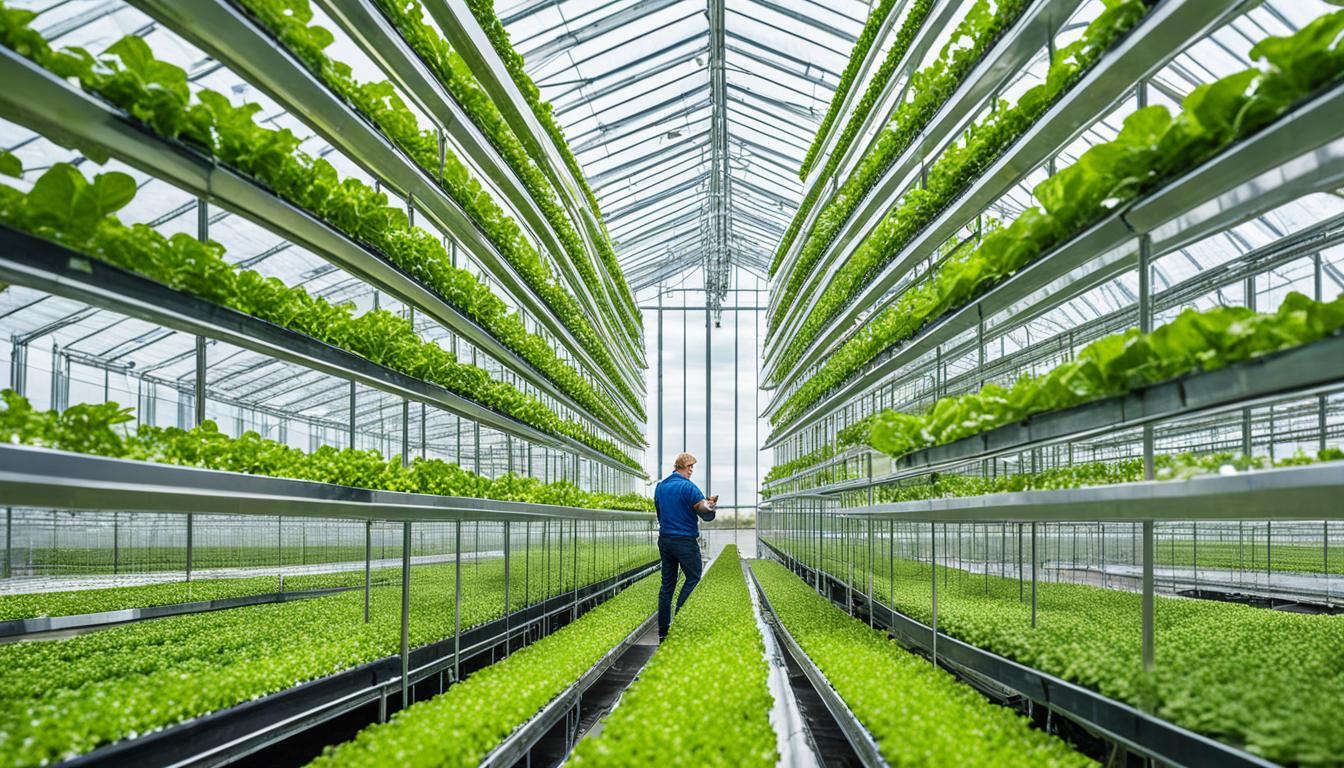
The Netherlands is the world’s second-biggest exporter of farm products, despite being small. The Dutch greenhouse industry is key to this success, helping to export €94.5 billion in farm foods in 2019. Thanks to techniques highlighted in David Attenborough’s show ‘A Life on Our Planet’, the country shines in farming under glass. It shows how they can grow a lot of food on a little space. This sets a great example for efficiency in farming.
Dutch greenhouse tech has led the way in growing plants for business over the last 100 years. It lets them farm fruits, veggies, and flowers no matter the weather. So, they can grow things like tomatoes in cold Siberia or cucumbers in hot deserts. This makes the Netherlands a top spot for smart farming ideas.
For more than a century, Dutch greenhouses have led the way in global horticulture. Their technology allows for the growing of many fruits, vegetables, and flowers. This is key for the Netherlands to compete internationally.
The history of Dutch greenhouse technology is full of innovation. For over 100 years, the Netherlands has been a leader in this field. They first saw greenhouses as a way to control the environment for farming.
Thanks to their work, now you can find tropical crops in cold places like Siberia. And, you can grow things like cucumbers in hot, dry deserts. The Dutch have found a way to balance cost and benefits perfectly in their greenhouses.
The Netherlands’ impact on global horticulture is huge. About 80% of their greenhouse-grown vegetables are sent abroad. This shows how important their technology and knowledge are around the world.
In 2005, this industry brought 4.6 billion euros to the country. Places like Westland and Venlo are key areas for the Dutch greenhouse trade. The government there invests a lot to keep these areas going strong.
| Region | Main Products | Employment Statistics (2005) |
|---|---|---|
| Westland | Ornamental flowers, vegetables | Approximately 51,000 individuals |
| Oostland | Cut flowers, pot plants | High recruitment from employment agencies (80%) |
| Venlo | Vegetables, fruits | 23% added value in greenhouse horticulture |
Dutch greenhouses continue to shape international trade. They’re a big part of the production chain. With lots of temporary workers, they meet the global demand efficiently. Dutch technology is always evolving. It keeps global horticulture moving forward.
The Netherlands leads in cutting-edge greenhouse technology. It brings together different fields to improve commercial farming worldwide. This approach focuses on balancing costs and profits smartly.
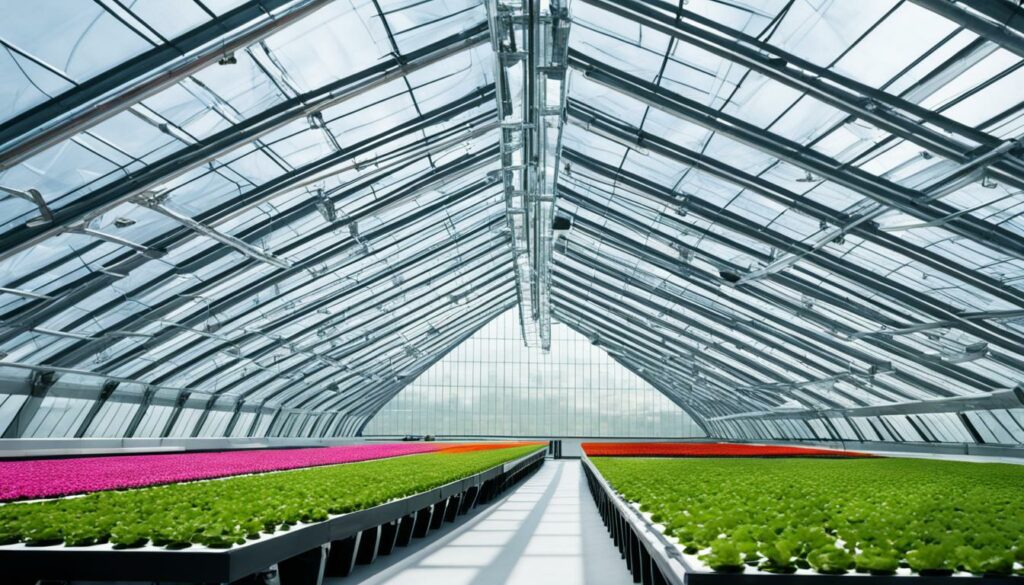
In Dutch greenhouses, high-tech systems regulate the climate perfectly. They manage temperature, humidity, and air circulation. This is key for growing crops like tomatoes and cucumbers in any season.
Such control means better crops and higher yield year-round. Farmers aren’t limited to just the usual growing period.
The country also excels in using LED growlights for plants. These lights imitate sunlight, keeping crop growth strong even in winter. They help Dutch farmers keep up high production throughout the year.
Automation has turned Dutch greenhouses high-tech. Sensors, robots, and automated tech do everything from watering to adjusting the climate.
This not only makes things run smoother but also saves resources. Thereby, the Dutch stay ahead in the global market, growing healthier crops.
By using the latest in greenhouse tech, the Netherlands is at the forefront of eco-friendly farming. It secures food for tomorrow while caring for the planet.
The Netherlands shines in the agriculture world due to its advanced greenhouse farming. This success is because of how efficient and productive they are. Such farming keeps the country at the top globally.
The country’s commercial horticulture does well thanks to its modern greenhouse tech. This tech helps grow more crops using fewer resources. Even with higher energy costs, Dutch greenhouse farms remain powerful in international markets. Yet, almost a third of them struggle financially, showing the importance of smart financial plans.
The Netherlands is the world’s second-largest exporter of farm products, in part due to greenhouse farming. In 2017, its agricultural exports were worth $111 billion. Flowers and vegetables made up a huge part of this, with $10 billion from flowers and $7.4 billion from vegetables.
This strong trade performance shows the global impact of Dutch greenhouses. Also, investments in mergers and acquisitions have grown. In 2020, there were 85 such deals, whereas there were only 45 in 2017. These successes come despite facing challenges like increased energy prices.
To see how well Dutch greenhouses are doing, look at some key numbers:
| Year | Mergers and Acquisitions | Annual Export Value ($ billion) | Percentage of Farms with Solvency Below 50% |
|---|---|---|---|
| 2017 | 45 | 111 | 28% |
| 2020 | 85 | 111 | 28% |
| 2021 | 85+ | – | – |
Being sustainable is crucial for the Netherlands. It’s a top exporter of farm products, making €94.5 billion in 2019. The country focuses on using fewer pesticides and less water in greenhouse farming. It also uses renewable energy to move towards sustainability more.
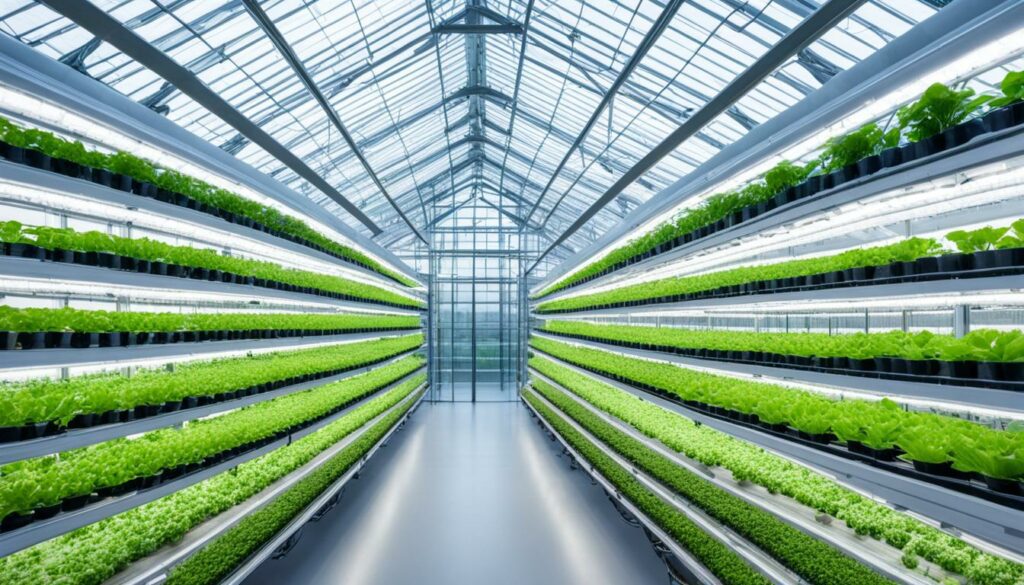
Reducing pesticide use and water in greenhouses is changing how farming is done. They use new tech like closed-loop watering and eco-friendly ways to control pests. This helps the environment and keeps crop yields high. In 2019, things like decorative flowers brought in €5.8 billion for the country.
The Netherlands is all about using renewable energy on farms. They’ve made greenhouses that save lots of energy. These special greenhouses can use 65% less energy than standard ones. They’ve also developed better ways to grow plants that use less energy.
The goal is for most Dutch farms to be about 55% sustainable. Their greenhouses alone use 80% of the energy in farming. Using more renewable energy will help the Netherlands stay a top food exporter, just after Germany.
For more on how the Dutch are making agriculture greener, check out this guide by EcoChain.
Dutch greenhouse tech has become a top standard worldwide. It gives farmers great control over their crops’ indoor environment. This success comes from combining many tech areas.
In Dutch greenhouses, tech like building design, mechanical, electrical work, energy engineering, and computers merge. This mix helps DutchGreenhouses® and others create perfect conditions for plants.
In tough climates such as Siberia and Canada, Dutch tech makes growing tomatoes and peppers possible. In hot deserts like the Middle East, it helps with growing cucumbers and lettuce. Important tech like climate control and grow lights boosts the amount and quality of crops.
The Dutch method focuses on smart turnkey greenhouse projects. These projects bring together different tech fields to create effective and affordable systems. They balance the cost with the benefits. This includes climate control and automation for better production and less energy waste.
The greenhouse from Optimal in Westdorpe shows it all works. It has a 13% bigger harvest and 14% sweeter fruits compared to regular Dutch greenhouses. Also, it saves 27% more power and lowers CO2 by 20%. This shows how important these smart projects are for better farming and the environment.
AI tech is also making a mark in greenhouse work. It joins human knowledge with the latest machinery to keep improving farming. Dutch greenhouses show how smart turnkey projects can change farming all around the world.
Hydroponic farming is key in changing how we grow plants in Dutch greenhouses. It allows growers in the Netherlands to be very efficient and get high yields. This puts them at the top of the agricultural world.

In the Netherlands, crops grow in water, not soil. They use nutrient-rich water. Techniques like Nutrient Film Technique (NFT) and Ebb & Flow are common. These methods help use less water and give plants exactly what they need to grow.
Hydroponics has many benefits. It’s very good with space and water. For instance, Dutch farms can get the same amount of produce on one acre as in ten acres of traditional farms.
They also use much less water. While it takes over 28 gallons of water for one pound of produce worldwide, in the Netherlands, hydroponics uses just half a gallon. This saves a lot of water and shows how efficient hydroponics is. With this method, crops grow all year round too.
Companies like Enza Zaden and PlantLab show the success of hydroponics in the Netherlands. Enza Zaden is a big player in this field. They spend $100 million every year on research to improve vegetable varieties. They grow almost a million tons of tomatoes each year in their greenhouses.
PlantLab, with a €50 million boost, is aiming even higher. They want to build 250 acres of vertical farms in the next ten years. This shows hydroponic farming’s transforming power and its ability to grow on a larger scale.
The Netherlands is at the forefront of hydroponic farming. They use this method to be sustainable and provide food globally. Their work in hydroponics sets a high standard for the world in farming practices.
The Netherlands leads the way in tackling food security through innovative greenhouse farming. These greenhouses use cutting-edge technology to grow lots of food in small spaces. This model offers a promising method to ensure there’s enough food for the world’s population.
In the Netherlands, farmers harvest almost twice as many potatoes from an acre as the world average shows. Jacob van den Borne, for instance, produces over 20 tons of potatoes per acre. This is a significant jump from the global average of nine tons.
The Duijvestijns’ greenhouses are also super efficient with water. They only use less than four gallons of water for every kilogram of tomatoes. This is much lower than the 16 gallons used for field tomatoes. Such efficiency plays a vital role in helping the world feed itself.
Despite its limited space, the Netherlands is the second largest food exporter by value globally. It achieves this feat by producing six percent of Europe’s food with just one percent of Europe’s farmland. In the last 20 years, Dutch farmers have cut down water use for crops by up to 90 percent.
The country is known for exporting a significant number of tomatoes and potatoes. Its success can be attributed to high-tech farming under controlled climates. This approach highlights their dedication to farming that is both environmentally friendly and productive.
| Key Statistics | Data Points |
|---|---|
| Potato Yield Per Acre | 20+ tons (Netherlands) vs 9 tons (Global average) |
| Water Usage for Tomatoes | |
| Food Production Share | 6% of Europe’s food with 1% of Europe’s farmland |
| Water Reduction | Up to 90% since 2000 |
The Dutch greenhouse sector is crucial for the future of food security. It is a model of efficiency and sustainability. Dutch practices show it’s possible to grow more food while protecting the environment.
Dutch greenhouse agriculture brings many sustainability perks. Yet, it struggles with high energy use and greenhouse gas emissions.
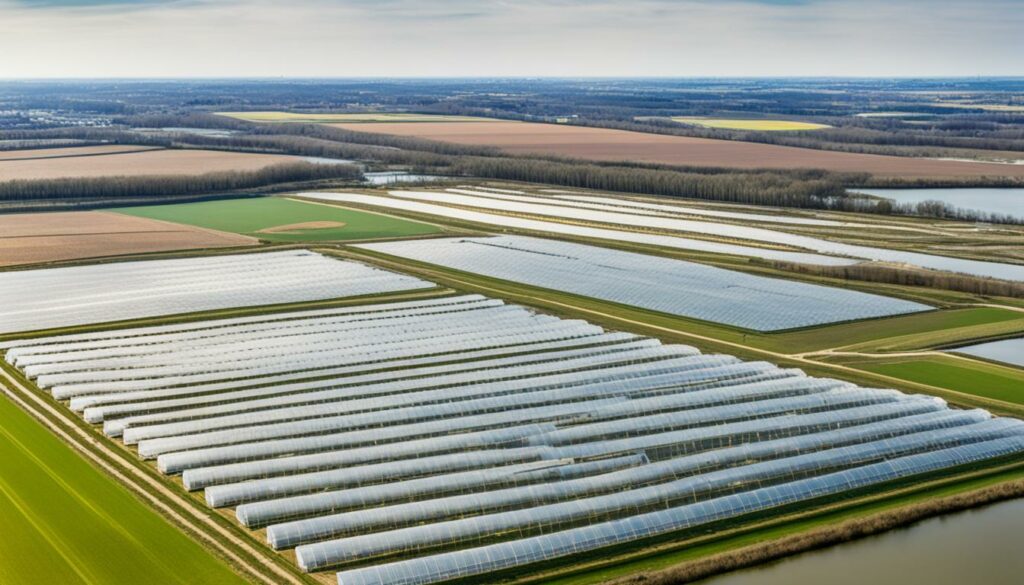
Dutch greenhouses use lots of energy. They eat up almost 80% of the country’s farm sector energy. This is a big issue and needs fixing. Greenhouses like the LEC model show promise. They could cut energy needs by almost two-thirds compared to regular greenhouses.
Even with better farming tech, Dutch greenhouses still produce too many greenhouse gases. In 2016, they made up 14% of the country’s total emissions. Livestock farming was the biggest contributor, making 66% of these gases. The goal is to greatly reduce these emissions by 2030.
Looking at data from other Northwest European countries, the challenges are much the same per product output. This underlines the need for careful assessments of how food is produced and delivered. We must make Dutch greenhouses less harmful by cutting greenhouse gases and using resources better.
The Netherlands stands out for its expertise in greenhouse technology. For over 100 years, it has been leading the world. It does this by using climate-controlled greenhouse systems. These systems create perfect conditions for various crops to grow well.
Advanced greenhouse heating and cooling technologies are key. They keep the perfect environment in Dutch greenhouses. With these methods, farmers can grow all kinds of crops, even in very cold or hot places. Thanks to Dutch ideas, crops from the tropics can thrive in colder areas and desert plants can grow, too.
Precise humidity and ventilation control is very important in these systems. This makes sure plants get the right moisture and air flow all year long. This control is vital for the best crop growth and harvest. Dutch science and engineering in structures, mechanics, computers, and agriculture combine to make sure farming is efficient and eco-friendly.
Dutch agriculture businesses use advanced climate systems wisely. They use these for heating and cooling, as well as for screening, shading, and automating their greenhouses. By considering costs and return on investment, they’ve made these systems not just effective but also good for the economy.
The Dutch have led the world in greenhouse technology for a long time. Now, they’re pushing the industry even further. One key area they’re exploring is urban farming and the use of vertical greenhouses.
There is a big focus on urban farming in the Netherlands’ greenhouse scene. This method aims to grow food closer to cities, which tackles issues related to land and transport. The country is known for using advanced climate control. It lets farmers grow various crops no matter the weather outside.
New tech makes growing tropical crops possible in cold places like Siberia. It also allows for the growth of cucumbers and lettuce in dry regions. This technology is getting better each year, aiming to make farming more affordable while still being profitable.
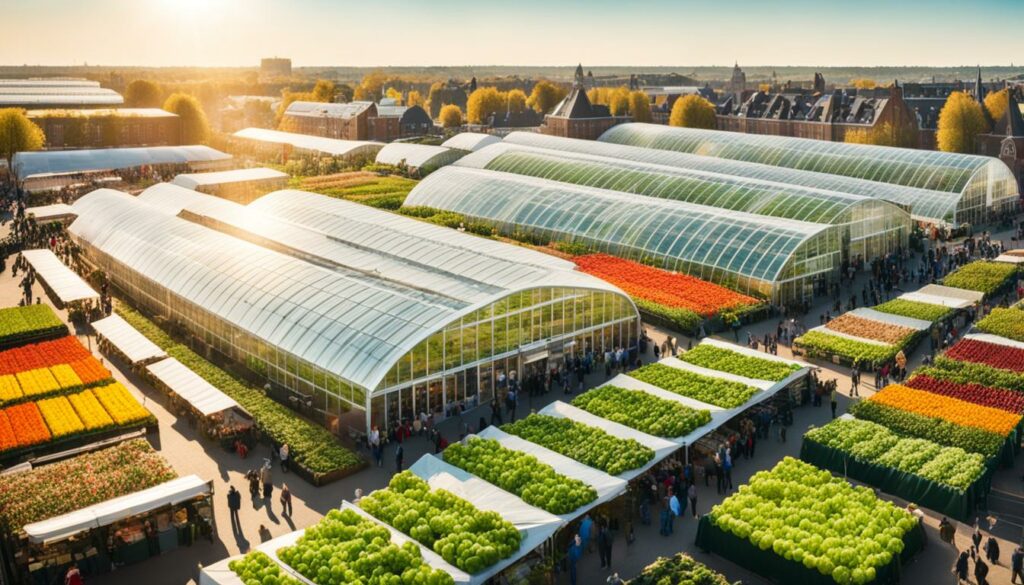
In the Netherlands, urban farming is on the rise. Vertical greenhouses are a big part of this. These structures stack crops on top of each other, multiplying the harvest from the same space. They rely on LED lights, automatic watering, and advanced climate control.
Vertical greenhouses maximize space and use energy wisely. They are part of the move to lower the carbon footprint of farming. This is because they lessen the need for transporting food over long distances.
Dutch greenhouses epitomize a blend of different expertises. From structural design to energy and agricultural systems, they merge various technologies. This fusion promises to keep Dutch greenhouse tech ahead in both productivity and environmental care.
| Key Technological Areas | Impact |
|---|---|
| Irrigation Systems | Efficient water usage and distribution |
| Grow Lights | Enhanced crop growth and yield |
| Climate Control | Year-round crop cultivation |
| Automation | Reduced labour costs, increased precision |
| Greenhouse Structures | Optimised space and resource utilisation |
In the Netherlands, greenhouse farming is a big success. Case studies show how efficient and innovative they are. Two key examples are tomato farming and growing ornamental flowers and plants.
Holland is the global leader in growing tomatoes in greenhouses. Jacob van den Borne is a Dutch farmer who produces more potatoes per acre than most others. His success shows how Dutch methods can outperform the world.
Tomatoes grown in Dutch greenhouses use very little water. This is thanks to their innovative ways of farming. In fibre-rooted systems, they use much less water than in traditional outdoor farming.
LED lights help Dutch tomato farmers grow their crops non-stop. This leads to high yields. It also means they don’t need to use as many harmful pesticides. This is a great example of how Dutch farmers care for the environment.
The Netherlands also leads in selling ornamental flowers. They use the latest technology to stay ahead. Their greenhouses are powered by geothermal energy and other efficient systems.
Dutch farmers have focused on using less water since 2000. They’ve cut down water use for certain crops by 90%. This change has made the quality of their flowers even better. They also use less chemical pesticides, showing their care for the environment.
| Key Metric | Tomato Cultivation | Ornamental Flowers and Plants |
|---|---|---|
| Water Usage Reduction | Up to 90% | Up to 90% |
| Use of Chemical Pesticides | Almost Eliminated | Almost Eliminated |
| LED Lighting Usage | Extensive | Extensive |
| Global Export Ranking | Top | Top |
The Dutch greenhouse farming model excels in growing tomatoes and ornamental plants. These results speak to the Dutch farmers’ creativity and commitment to greener farming methods.
The Netherlands has set up many educational schemes to help greenhouse farmers. This training makes sure that those working in greenhouses have the right skills and knowledge. It helps make greenhouse farming more sustainable and productive.
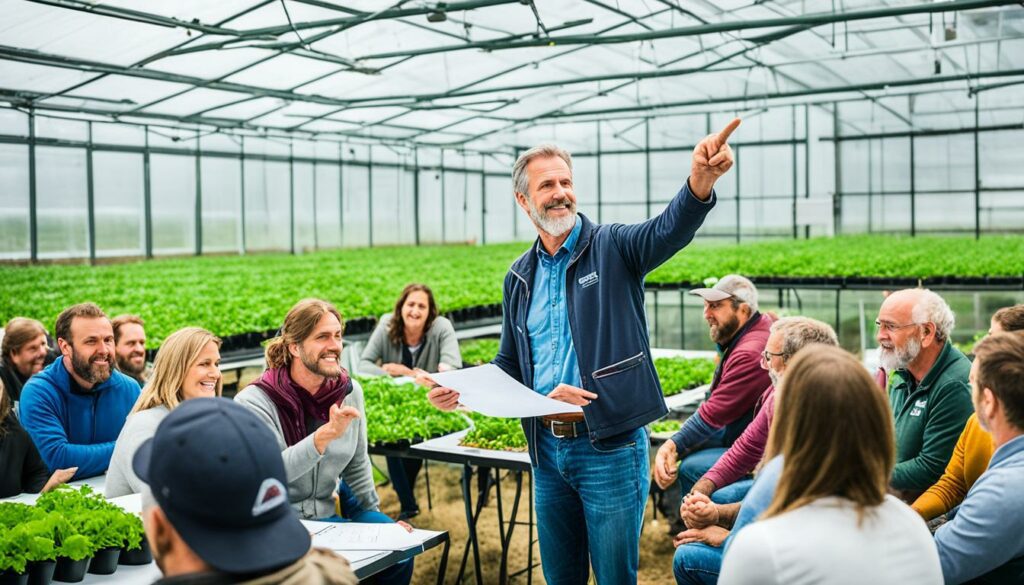
There are many programs and workshops for people at all levels, from PhD students to professionals. They cover lots of topics, like how greenhouses work, managing the climate, and pest control. This wide range of subjects gives participants a full picture of greenhouse farming.
People who have taken these training programs often say they are very good. They have used what they learned to help make their work better. They also help make greenhouse farming more eco-friendly.
| Statistic | Value |
|---|---|
| Total area of greenhouse farming in the Netherlands | 35,000 hectares |
| Number of farmers engaged in greenhouse production | 15,000 |
| Jobs created by the greenhouse industry | 40,000 |
| Economic value of primary and auxiliary industries | Over EUR 3400 million |
The Netherlands brings together many groups to improve greenhouse farming. This team effort helps bring in new technologies and knowledge. It shows how important ongoing greenhouse education and horticulture training are. This work has made the Netherlands a leading example in green, sustainable agriculture.
Dutch greenhouse practices bring great growth in farming, but they get criticism too. These criticisms mostly focus on environmental issues. The high energy use and emissions from these practices spark debate on finding better, more sustainable ways.
In the Netherlands, greenhouses use a lot of energy. Nearly 80% of the country’s agricultural energy goes to heating these greenhouses. It’s clear they need to use less fossil fuel to help the planet.
This industry also puts out a lot of greenhouse gases. In fact, in 2016, Dutch farming and horticulture were responsible for 14% of the nation’s emissions. These numbers show the need for greener practices.
The Dutch are working hard to make their horticulture more eco-friendly. They created the LEC greenhouse, which dramatically cuts energy use. Also, vertical farming is proving to be a better use of energy and resources than traditional methods.
Waste is a big issue too. Greenhouses produce a lot of it, leading to heavy energy use in disposal. Finding ways to deal with waste that are kinder to the environment is crucial. It’s all about finding a balance between farming well and protecting the earth.
In the Netherlands, greenhouse farming is a model of both new ideas and effectiveness. In 2019, they sold agricultural goods worth a huge €94.5 billion. A big part of this was ornamental flowers and plants, bringing in €5.8 billion. This shows how vital the Netherlands is in farming globally.
The country also made €8.3 billion from dairy, eggs, and meat. This rich variety highlights how strong the farming sector is. But, it’s not all good news. The big issue is sustainability. Dutch farming makes up 14% of the nation’s greenhouse gas emissions. Greenhouses use about 80% of farming’s energy.
There are answers to these challenges, like the LEC greenhouse designed by a team from the Netherlands, Germany, and Denmark. This technology could cut down energy use by 65%. Vertical farming is also improving, using less energy and space to grow more. Farms are using LED lights, geothermal power, and capturing CO2 from the air. These steps are key to lessening their environmental impact.
The future of Dutch horticulture relies on automation and new technology to stay ahead. Focusing on being more sustainable and efficient is crucial. This not only secures Dutch farming’s future but also offers ideas to help worldwide agricultural problems. Using sustainable farming methods is vital for our earth and economy.
For over a hundred years, the Netherlands has led in greenhouse technology. They can grow all kinds of crops in any weather. This has even led to tropical fruits growing in colder places.
They do this by selling top-quality items. These include pretty flowers, plants, dairy, and eggs. The Netherlands made €94.5 billion in sales from these products in 2019.
They have amazing systems for climate control and special lighting. They also use a lot of automation. This makes “smart” greenhouses that grow more and better crops.
Greenhouses have made the Netherlands a big food exporter. This has been great for their economy. They export a lot of their food all over the world.
They focus on using less pesticides and water. They also use clean energy sources, like geothermal heating. This makes their farms better for the planet.
They use a lot of different types of technology. This includes building, equipment, and energy systems. It all helps to make the best conditions for growing plants.
Hydroponics is farming without soil. It’s great for saving space and using less water. The Dutch find it very useful for growing more food in limited areas.
It lets them grow lots of food without needing more land. This way, they help feed more people worldwide without harming the environment as much.
Greenhouse farming uses a lot of energy and creates greenhouse gases. This is still a problem, even with all their technology. They need to find ways to make it cleaner.
They use the latest in heating, cooling, and humidity control. This keeps the plants happy all year. It’s all about giving plants the best conditions to grow in.
They’re looking at farming more in cities and using more vertical greenhouses. This should make growing food even more energy-efficient and productive.
They’ve done really well with growing tomatoes. Their flower and plant industry is also thriving. These show how careful farming can bring a lot of money.
It’s really important. They train people in both the tech and the knowledge needed. This makes sure the greenhouses are run well by skilled people.
Greenhouses here produce a lot of emissions and use a lot of fossil fuels. They need to find a balance between growing food and protecting the environment.